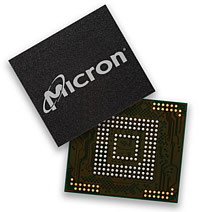
Micron Announces QuantX Branding For 3D XPoint Memory, Releases 3D NAND flash for Mobile Devices
At Flash Memory Summit 2016, Micron unveiled the Micron QuantX technology solutions that incorporates their 3D XPoint memory and announced sampling of its first 3D NAND flash memory to mobile device manufacturers. 3D Xpoint memory was jointly announced by Intel and Micron shortly before last year's Flash Memory Summit. The revolutionary new memory sports up to 1,000 times the performance of NAND flash.
The new QuantX brand is Micron's counterpart to Intel's Optane brand and the first generation of QuantX solid-state drives will be aimed squarely at data center applications beginning in the second quarter of 2017. Before then, Intel will likely have its own Optane data center SSDs out.
Sometime down the road, QuantX may find its way into mobile computer applications, but that won't likely be for some time.
Currently, Micron is planning to see its first revenues from QuantX sales in the second half of 2017, with 2018 being a "bigger year," and 2019 being the "break-out" revenue year, the company said.
3D XPoint is primarily a mass storage-class memory that, while slower, is cheaper to produce than DRAM and vastly faster than NAND.
3D Xpoint will be about half the price of DRAM, but around four to five times more expensive than NAND flash. So while it will replace DRAM for many applications, it's not likely to replace NAND flash -- at least for prosumer applications -- anytime soon.
By the end of this year, Intel may also bring out Optane SSDs for the client market, though it's more likely that they'll ship in the first quarter of 2017.
Micron plans on partnering with manufacturing partners to release SSDs that will be able to replace both NAND flash and DRAM depending on the applications. Micron has already been shipping test models to those partners.
Mobile 3D NAND
Micron also today introduced the company's first 3D NAND memory technology optimized for mobile devices and its first products based on the Universal Flash Storage (UFS) 2.1 standard.
Micron's initial mobile 3D NAND-based 32GB solution is targeted specifically for the high and mid-end smartphone segments.

"Micron continues to advance NAND technology with our introduction of 3D NAND and UFS products for the mobile segment," said Mike Rayfield, vice president of Micron's mobile business unit. "The improved performance, higher capacity and enhanced reliability of 3D NAND will help our customers meet the ever-growing demand for mobile storage and will enable much more exciting end user experiences."
Micron 3D NAND technology stacks layers of data storage cells vertically with extraordinary precision to create storage solutions with three times more capacity than previous generation planar NAND technologies. Because capacity is achieved by stacking cells vertically, Micron is able to pack more storage cells into a much smaller die area, resulting in the delivery of a very small 3D NAND memory die measuring only 60.217mm2. A smaller die enables a tiny memory packaging footprint which can free up space for additional mobile battery size or enable smaller form factor devices.
 Micron's first 3D NAND for mobile offers several technical advantages. New features include:
Micron's first 3D NAND for mobile offers several technical advantages. New features include:
- First mobile product built on floating gate technology, a universally utilized design refined through years of high-volume planar flash manufacturing
- Micron's first memory devices with UFS 2.1 standard, which enable a great Sequential Read Performance for the mobile market
- 3D NAND-based multichip packages (MCPs) also include low power LPDDR4X, providing up to 20 percent more energy efficiency than standard LPDDR4 memory
- Industry's smallest 3D NAND memory die, measuring only 60.217mm2, allows tiny memory packaging; Micron's 3D NAND die is up to 30% smaller than planar NAND die of the same capacity.
Micron's 3D NAND solutions for mobile are now sampling with the company's mobile customers and partners and will be widely available by the end of 2016.





















